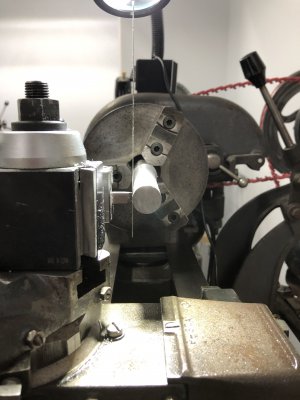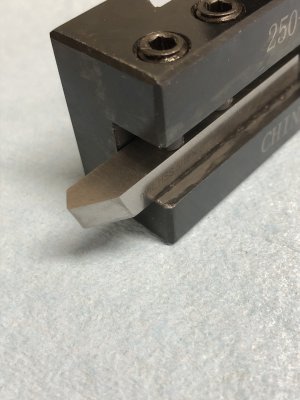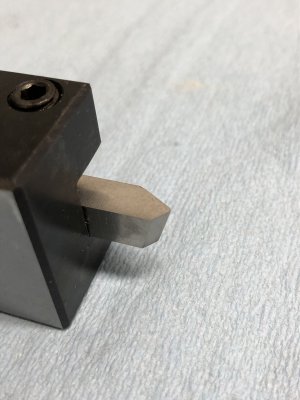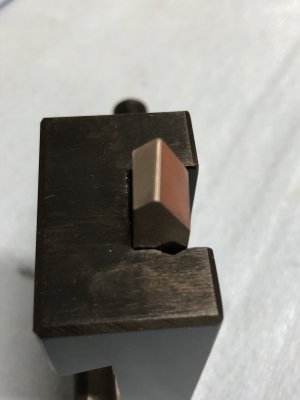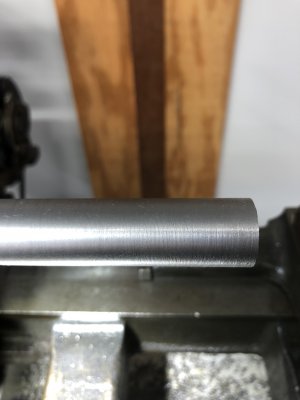I do plan to remove the the Legs from the Angle Iron and Castors but for now need it to be somewhat mobile as I rearrange the shop.
Until you have the lathe sited and stable, leveling it is a waste of time. Just use it as is until you can get it in a place where you won't need to move it for a while. You should know that leveling casters, chosen properly to support the weight of your machine, will allow for mobility when you need it and solidity when you don't. I recommend Carrymaster casters if you go this route, and go one weight class higher than your machine actually weighs. With the levelers down, it will be as solid as typical machine mounts would be.
I'll try to give you some tips on leveling.
Whenever you do test cuts, always try to use HSS and make sure it is honed sharp. Keep any nose radius on the tool small, in the 1/32" range, to keep deflection minimized. A good tool with adequate relief and rake angles will cut a softish test bar (12L14, 6061-T6 aluminum) without deflecting much at all when taking small depths of cut. It should also provide a decent finish so that your mic reads accurately.
It is my opinion that doing test cuts is the most accurate way to set up a lathe because it self proves your changes. If you cut and change something, subsequent cuts will show the impact of those changes. I don't like calculations and I won't rely on a MT test bar because of stacking tolerances. This is just my opinion and may not jive with what others prefer.
I further believe that the proper way to set up a lathe is to evaluate the alignment of the headstock with the ways first. If the headstock is off then anything else that relies on that alignment will also be off, including a 2-collar test or tailstock alignment. Some headstocks do not allow for adjustment and may be indexed on the ways. Typically, these will be fairly accurately situated because they are ground to fit. High end lathes will typically allow for some form of precision alignment so you have to check how yours is set up. The best way to assess how accurately the headstock is aligned is with a test cut.
- Lock a 6" long piece of 1-2" OD 12L14 or 6061 in a 3 jaw chuck, leaving about 4" sticking out. Since this is a first operation, any cuts you take will produce a diameter that is dead on the spindle centerline. The reason for the largish diameter stock is reduce deflection from the cutting forces the tool generates. No tailstock support is used for this kind of testing.
- Use a sharp HSS tool and take a 0.010" deep cut to remove the skin and make the piece roundish; cut from the end towards the chuck and stop about 1/2" from the chuck. Then take a 0.003" deep cut to refine the diameter and strive for a good finish. Finally, take a 0.001-0.002" deep cut at a slower feed and go for a good finish. Use cutting oil for all these cuts. The last cut should give you a finish that will be good enough to read with a micrometer.
- Clean the work piece well - wipe it dry, wipe again with alcohol, wipe to dry. Mic the diameter at the end and up close to the chuck. If they are different then the headstock is off relative to the ways. If the end is bigger, the headstock has to be adjusted towards you, and vice versa. Adjust if possible and make test cuts until you nail the alignment. NOW you can level the lathe.
As you know, leveling a lathe is simply assuring the ways of the lathe are coplanar to one another. It has nothing to do with the machine itself being level with the surface on which it sits. A lathe left to sit on a surface will not move much with gravity; we usually have to apply some force to it to get it to move into alignment. To do that, you have to have some way to apply force to the structure of the lathe so that any misalignment of the ways can be corrected. Some lathes have leveling adjusters under the feet of the lathe to allow for precision alignment; my Super 11 is like this. Others must be shimmed, and some lathes bolt to a solid cabinet and adjusting levelers on the bottom of the cabinet are used to twist the lathe that sits on it. I'm not sure how yours is set up but if you do not already have leveling adjusters underneath the feet of your lathe, I recommend you consider fabricating some. It will save you gobs of time and frustration over the years and make leveling your lathe simple.
Okay, you need a spirit level to level your lathe. To be clear, the level is just to get you close and you will finalize your leveling with test cuts done in a 2-collar test (you can look this up) regardless of which level you use. The more sensitive the level is, the fewer test cuts you will need to make to dial in your lathe. A Starrett 98 is good to 0.005"/foot. Most precision machinist levels are good to about 0.0002"/10", so quite a bit more sensitive. You can buy a precision level like this on ebay for under $100.00 nowadays. Again, the more sensitive levels will save you TIME. Imagine if you have to shim your lathe to level it. You shim, test cut, shim, test cut, etc. The more sensitive levels will reduce the number of times you have to do this significantly. If you have to adjust levelers under the cabinet, a better level will save your knees and back. What the Starrett 98 is good for is to get you close. The bubble on a precision level is extremely sensitive and you will spend a lot of time chasing it before it settles down. I use a 98-6 and get the lathe level at both ends of the lathe with that, then switch to my Kinex precision level to finalize adjustments.
Leveling is pretty simple for me. First, I level my cabinet so it is level with the ground; this just simplifies what follows. The ways on my lathe are not at the same level; the rear is lower than the front, so I position my level on the cross slide bed. I remove the compound, clean the cross slide thoroughly, then put the level so that the long axis of the level runs along the long axis of the cross slide. I use a square to align it square to the cross slide and it sits there without me touching it, ever. I run the saddle towards the headstock end and adjust the level on that end with the adjusters under the headstock, then run the saddle to the tailstock end and do the same thing. My lathe allows me to adjust support bolts underneath the feet and then lock it down so it cannot move, and I can do this at either end of the lathe so leveling is quick and easy. Yours may not be so easy.
In any case, once I get the lathe leveled with the 98-6, I repeat this with the Kinex and make whatever fine adjustments are required to get the lathe as dead on as I can. Quite often, I will be a fraction of a unit off on one or both ends. At that point, I stop using the adjusters underneath the lathe and do test cuts on a 2-collar bar. In most cases, I will be off a few tenths between the diameters and I adjust the levelers
underneath the cabinet to dial the cuts in. Typically, I can dial out any difference between the collars within a few cuts and I'm done.
All that remains is to align the tailstock and I use a test bar cut on my lathe to do that.
Done.
You said you're trying to learn to level your lathe. I hope this helps. I level my lathe if I move it or at my 6 month maintenance interval or if I turn a big piece that imparted any imbalance to the lathe. This only takes me a few minutes with a 2-collar bar and keeps my lathe cutting well.
I just looked at your tool and I suggest you grind some rake angles on your tool; it will reduce cutting forces significantly and make the tool more accurate. A really good tool can take a 0.0005" cut (or less) and actually cut it. Carbide cannot do this.
Finally, remember that all lathes move. You can nail the level on your lathe and feel like a manly-man, only to come back in a few days and find that it is a little bit off. This is just the nature of the beast. I suggest you level the lathe, wait 1-2 weeks and level it again, then check it in a month. By then, it will have settled down.


